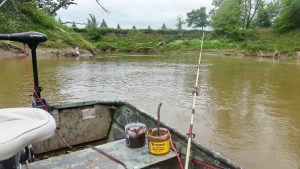The author’s daughter Maia likes fishing dip bait, as she doesn’t have
to cut up bloody bait. The circle hook makes it easy to hook the cats.
Don’t Forget the Dip Bait
Story and photos by Jeffrey Miller
Smelly dip baits may wrinkle noses, but they are proven channel cat getters.
There are some scents that invoke strong memories. Beaver castor lure on a springtime morning on the trapline. Hoppe’s Number 9 when cleaning a gun after a successful hunt. And the nose wrinkling smell of a good dip bait on a summer excursion on the river.
Dip baits, in one form or another, have been around for quite some time. Doc’s Catfish Getter Dip Bait has been around in one form or another since 1927. Another old timer is Bowker, which have been around nearly as long.
No matter the manufacturer, nearly all dip baits use cheese as the base ingredient. Baits consisting of fish matter, like cut bait, exude blood into the water. Catfish are drawn to the amino acids in the blood, triggering a hunger response. Cheese, on the other hand, has both amino and lactic acids. As the matter drifts in the water, there is double the attraction for hungry fish. When blood is added to the mix, it is even more attractive.

When the dip bait hits the water, the lactic acid starts dispersing immediately, while the amino acids ooze out more slowly. As catfish have taste buds all over their scaleless bodies, the influx of scent in the water helps draw them to the bait.
Though the odd blue or flathead may strike a dip-bait-laden tube, it is primarily channel catfish that are targeted using the bait.
Pre-made rubber worms for dip bait usually come with a small treble hook attached. I learned very quickly that, while they work great, most of the fish caught would swallow the bait. That was fine if it was an eater-sized fish, but fish too small or too big required the line to be cut and the hook left in.
A much better option is a tube worm and circle hook. The tube worm, made from surgical tubing, has hole in it that does a great job of holding onto the bait. They can be purchased in bulk very inexpensively in a variety of colors.
Circle hooks are a must when catfishing. Not only does they seem to do a better job sticking cats, at least for me, they nearly always hook a fish perfectly in the lip. Even when a fish swallows the bait, a circle hook will slide up the throat and lodge in the corner of the mouth. The only drawback to a circle hook is there is no need for a big hookset. My daughters have mastered the art of simply reeling in when a fish strikes, but guests often cannot wrap their mind around it. After missing a few fish, they usually settle down and get the hang of it.
With a wide variety of dip baits available, each angler should experiment to find the one they like best. A container of bait is inexpensive, so purchase a few to try in varying conditions. Some are thicker, some thinner, and all have different ingredients. Some fish love cheese, some blood, some garlic. Trial and error will help narrow down the brand and ingredients.
In the northern part of the country, rivers and streams lay under ice for five months or so a year. Additionally, before freeze-up or just after break-up, the water is extremely cold. I’ve tried dip baits from spring until fall and find that in cold water they just don’t produce as well as cut-bait or night crawlers.

As the dog days of summer descend, bringing with them hot, dry days and warm, tepid nights, the dips start taking fish. Here in North Dakota, I catch the most catfish from the end of June through late August. I especially like to fish during a stretch of stable weather conditions or just after a rain.
It’s hard to beat the standard run riffle pool technique for finding summer catfish. Even the mighty Red River is small enough to throw a baseball across, and rivers even smaller readily show their secrets without needing a graph. As the heat of the summer causes the rivers to run slower and shallower, the bigger fish concentrate in the deeper water of holes or where eddy action around debris causes deep water.
In North Dakota, anglers are allowed two rods per person. I tend to lob one bait on the inside of the bend or brush, closer to the shore. The other is tossed toward the middle of the river, toward the current. More active fish will be in the current, while more sedentary fish will be resting in the slow water. The dip bait will leach scent into both places.
I always have different flavors and brands of dips in the boat and will never use the same dip on two lines. I will usually have one cheese and one blood, or a blood on each but from different manufacturers. An angler never knows what the fish will prefer that day, and it pays to give them plenty of options.
When using a boat, or when able to change locations, I tend to only spend 20 minutes or so on a specific spot. Though it’s relaxing to sit on a riverbend all afternoon, when actively trying to catch fish, I want to find the action. The hungry fish don’t let the bait sit long.

While fishing dip bait is a great tactic for catching a mess of eaters, it is by no means only for small fish. The top-end channel cat size for my local river is around 33 to 34 inches, and I’ve caught nearly all my fish that size on dip baits during the heat of the summer. If the first few fish out of a hole or snag are small fiddlers, I’ll likely move on to the next spot if I’m looking for a trophy. Big fish tend to rule the roost and are the first fish caught.
My biggest home-water catfish, a beauty that measured just under 34 inches, was caught on Triple S blood bait, formerly known as Sonny’s. I had just anchored up next to a small pile of brush in a deep bend in the river. After casting my first rig near the shore, I was in the process of pitching the second when the rod slammed on the gunwale of the boat.
I barely had time to put the second rod in the holder and knew instantly it was a good fish. It pulsed deep in the water, refusing to give me an inch of line. The 17-pound-test monofilament line was stretched to the limit, but I was slowly able to guide the fish away from the brush and into the main channel.
After a protracted battle, the fish finally broke the surface. In my 10-foot johnboat, it was a balancing act trying to keep the fish up with one hand while readying the net with the other. Finally, after a couple tries, I brought the big cat into the boat. Perfectly hooked in the corner of the mouth, the tube worm was still loaded with dip bait.
(Jeffrey Miller is a freelance outdoor writer who has been published in over 20 magazines and newspapers on such diverse topics as hunting, fishing, fur trapping, gardening and modern homesteading. He is the author of three books.)



